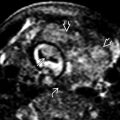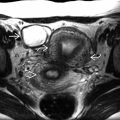KEY FACTS
Terminology
- •
Cystic lymphatic disorder involving back and side of neck causing multiseptated fluid-filled mass
Imaging
- •
Cystic hygroma (CH) is typically large
- ○
Multiple internal septations is key to diagnosis
- ○
Different than isolated ↑ nuchal translucency because of size and septations
- ○
- •
Associated with hydrops
- ○
Hydrops defined as fluid in 2 anatomic areas
- ○
CH counts as 1 area: Additional findings include pleural effusion, ascites, skin edema beyond neck
- ○
CH and hydrops can be diagnosed in 1st trimester
- ○
- •
Highly associated with aneuploidy and syndromes (2/3)
- ○
Turner syndrome (monosomy X): Most common
- ○
Trisomy 21: 2nd most common
- ○
Others: Trisomy 18, trisomy 13, Noonan syndrome, other syndromes
- ○
Top Differential Diagnoses
- •
Body/trunk lymphangioma
- ○
Less likely to cause hydrops, not associated with aneuploidy
- ○
- •
Occipital encephalocele: Calvarial defect + brain anomaly
- •
Cervical teratoma: Solid and cystic mass
Clinical Issues
- •
CH + hydrops is grim finding, high mortality rates
- •
Small isolated CH may resolve
- •
Genetic counseling recommended for all cases
Scanning Tips
- •
Use high-resolution probe to look for septations
- •
Large CH may mimic pocket of amniotic fluid
- ○
Move patient to move fetus away from uterine wall
- ○
- •
CH may be only “tapable” pocket of fluid for amniocentesis, karyotype is possible with this technique
 . The midline septation
. The midline septation  is the nuchal ligament. Oligohydramnios was also present. If fluid for genetic testing is desired, and there are no other accessible fluid pockets, the CH can be sampled for testing.
is the nuchal ligament. Oligohydramnios was also present. If fluid for genetic testing is desired, and there are no other accessible fluid pockets, the CH can be sampled for testing.
 . CH, hydrops, and Turner syndrome are common associations.
. CH, hydrops, and Turner syndrome are common associations.
 , allowing for a more accurate diagnosis of CH, rather than simply increased NT.
, allowing for a more accurate diagnosis of CH, rather than simply increased NT.
Stay updated, free articles. Join our Telegram channel

Full access? Get Clinical Tree








